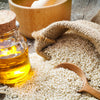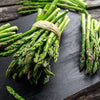What are the most important vegetables and fruits to only buy organic?

They call it the "Dirty Dozen." And they’re not talking about a movie about the famous Western.
They’re talking about vegetables and fruits that are the most toxic and the most dangerous to consume unless you buy organic varieties only. Keep reading to discover what you need to know before your next food shopping trip.
Why you want to avoid the "Dirty Dozen" in your diet
The Dirty Dozen is a list updated yearly by the Environmental Working Group (EWG) and we feel it is important to consult because it tells us the most chemical and toxin-laden conventional fruits and vegetables being imported into America.
Much of our crops are imported from countries that use DDT and equally dangerous pesticides.
In fact, we import many of our fruits and vegetables from countries that care little about practicing organic farming methods for growing food. The truth is: these commercial farmers tend to value the almighty dollar over public safety concerns.
For example, tea crops are quite valuable in the orient. But, the farm workers sent out to maintain these crops are sent out wearing little triangular metal caps so the DDT can spill off the hat and back onto the ground because they’re right out there while the DDT is being dumped onto the crops. After all, why waste valuable DDT, right?
For another example: we import coffee directly from Columbia, where they use a pesticide called BHC to spray their crops that has been banned in the U.S. since 1978. We hope this will make you think twice about the quality of your coffee.
Never underestimate the value of "knowing the source" of where your food comes from.
Food WARNING: Here is the "Dirty Dozen" food list to avoid
As mentioned before, the Dirty Dozen List comes out once per year. So be sure to look for updates on a yearly basis.
Meanwhile, here are the vegetables and fruits that have tested highest for pesticides and dangerous residues of toxins that we should only buy organic, or don’t buy at all.
Please note: They changed this to the "dirty 13" this year to add on hot peppers of all varieties.
- Strawberries
- Spinach
- Kale
- Nectarines
- Apples
- Grapes
- Peaches
- Cherries
- Pears
- Tomatoes
- Celery
- Potatoes
- Hot Peppers
How dirty are the dirty dozen?
To illustrate how dirty the top two vegetables and fruits might be, kale, a vegetable we encourage you to eat often (if eaten organic!), 81% of all conventional kale tested positive for over 18 pesticides, including a deadly, cancer-causing pesticide called Dacthal, or DCPA, which was found on 60% of the kale samples tested.
Buy these organic. Heck, buy everything organic if you are blessed to afford them or grow your own favorite veggies that you eat often like these!
You can grow your own bitter greens and freeze them in big freezer bags just like you see at the store. Then you’ll have safe kale and other veggies all year!
How Clean are the Clean 15?
For 2019, the Clean 15 – produce that are safe to buy in their cheaper conventional forms, the EWG listed the following.
- Avocados
- Sweet Corn
- Pineapples
- Sweet Peas Frozen
- Onions
- Papayas
- Eggplants
- Asparagus
- Kiwi
- Cabbage
- Cauliflower
- Cantaloupe
- Broccoli
- Mushrooms
- Honeydew Melons
By the way, the cleanest fruits – yes, corn and avocados are fruits, were avocados and sweet corn. In fact, less than 1% of these two fruits tested positive for any pesticide residues whatsoever. With the exception of cabbage, all the rest tested positive for 4 pesticide residues.
If you can afford it and climate permits, growing your own vegetables, particularly for things you eat every day like salad veggies and potatoes, is always advisable.
Sources for this article include:






